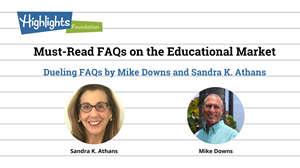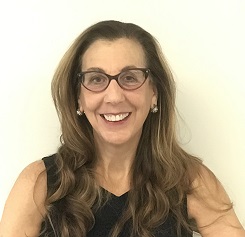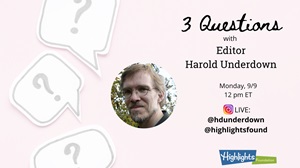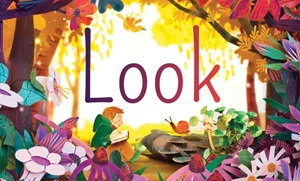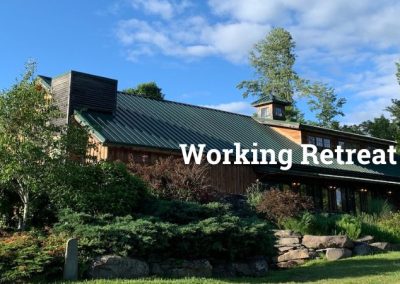Must-Read FAQs on the Educational Market
Dueling FAQs by Mike Downs and Sandra K. Athans
How does AI affect my educational writing?
Mike:
Great question! The answer is…it depends. The rapid growth and improvement of AI writing models ensures that this answer is constantly changing. Today, some companies allow the use of AI as long as you’re transparent about how you use it. Other companies still restrict or prohibit its use. Once you’ve been awarded a project, carefully read the publisher’s “writer’s guidelines” to determine their rules. If you have any questions, your editor will be able to answer them.
Sandra:
Mike’s response is spot on; check your guidelines! Yet some seasoned educational writers use AI to brainstorm ideas. Others new to the market sometimes use it to build background on unfamiliar topics, especially if they’re asked to submit a specific sample prior to landing an assignment. That said, AI is gaining in sophistication yet is still unreliable and should be considered only one resource among others that are more reliable, credible, and current. My advice is to explore AI (outside of your ed writing project) and stay on top of its use in the market. A final note on AI is that publishers as well as writers often have very strong opinions on AI. Enjoy the fun of forming your opinion!
What changes are taking place in educational books today?
Mike:
Part of the educational market is the same as ever. You’ll find opportunity writing nonfiction photo-illustrated picture books, poetry and fiction. But there are also a couple of current trends. Publishers today are looking for more own voices, authentic writers, and the point of view they can provide. Also, you’ll find more opportunity for writing stories in verse.
Sandra:
For those with teaching experience, the educational market is booming with new opportunity! Publishers in this niche are eager to find writers for teacher guides, student quizzes, reading passages, lesson plans, and more. A few current trends include foreign language materials, early phonics instruction, and “hi-lo” books which are high-interest fiction and nonfiction books written at low reading levels.
What standards are used in educational books?
Mike:
Different publishers will use different standards depending on the project. These standards are typically pulled from the Common Core State Standards (CCSS), the Next Generation Science Standards (NGSS), or other major state standards. But don’t stress about studying up on them. If the publisher is including standards in one of your projects, they will note the actual standard and the section you need to include it in. It’s not difficult to do, because simply writing the book according to their guidelines will generally cover the standard without any additional effort on your part.
Sandra:
Ditto what Mike said! However, some publishers might ask if you’re familiar with the CCSS, NGSS, or other standards prior to adding you to their writing team. These specialty Ed market publishers (sometimes called “content development houses”) produce curriculum projects for other “client” companies. Often these houses bid on projects, and your familiarity with the standards might be a small asset they’ll share during the bidding process. There’s no harm in quickly reviewing the standards so you can say you’re “familiar” with them. But once you’re on their team and the writing begins, you’ll be given everything you need.
How can I get an idea on what tone to use in a project I’ve been assigned? Humorous? Straightforward? Or…?
Mike:
The easiest way is to ask your editor for a couple of books that were previously written for the series you are now working on. The editor will be happy to provide these in pdf format. Use the same tone as these mentor texts.
Sandra:
If it were always that simple! You might find you’re working on a new series and the tone isn’t well defined. But there’s more on this in Question 5 below. Yet adding to Mike’s suggestion, you can also peruse a publisher’s catalogue. Sometimes they show sample pages from multiple volumes in their series. This can supplement the pdf samples your editor provides.
What is the difference between writing a book for a new series versus writing a book for an existing series?
Mike:
If you’ve been assigned a project on a new series…Hurrah! And – boy, oh boy, oh boy – anything can happen. With a preexisting series you have mentor texts that are easy to replicate in terms of tone, length, and content. That definitely makes it easier. In a new series, you have only your writer’s guidelines to follow, which should be enough, right? Well… In a new series the editors will frequently change their mind on the exact format, content, or tone of the book until they’re happy with their new project. This translates to repeated requests for changes to the author. Still, it’s fun to be the first author in a new series!
Sandra:
Sheesh! While my definition of “fun” is a bit different than Mike’s, your flexibility and willingness to help editors polish a new “loosely-defined” series will go far! No doubt you’ll become their “go-to” writer whenever they’re beginning a new series – and they’re always beginning new series! While the wear and tear on your time and patience may be strained, you’ll earn an A+ reputation and gain innumerable rewards — more of the same kind of work!
How many edits will I have to make?
Mike:
The answer is…you’ll have to make edits until the editor and publisher are happy with the project. With my own projects, this normally translates into about two to three months of back and forth with my editor. The better your first outline is, the fewer edits you will need. Also, editors are always limited by a timeline to finish the project and get books out on time. In contrast, I do have a writer acquaintance who pitches projects. She says she puts in her contract a limit of two rewrites – though she is highly experienced and pitches and writes fictional series.
Sandra:
The number of edits vary with the project. On a few big projects I’ve worked on for content development houses (see question 3), I’ve had up to five edits (or passes), which often require small tweaks, not major rewrites. This is because the client also has a say in the project. Your editor might rework your material and have you move forward, following gently updated guidelines. If major rework is required on your part, your editor might tack a few extra dollars to compensate you. Yet these kinds of problems are fixed very early.
Is it easy to make changes to the contract the publisher sends to its writers?
Mike:
Yikes! I wish! It is impossible to make changes to an educational publisher’s contract, or nearly so. Over the past few years, I’ve tried to get a small increase in pay or additional author copies of my books. This has never worked. Educational publishers still wield a heavy hand with the contracts they impose. To put it succinctly, sign the contract or they will hire a different author. I’m hopeful this could change in the future.
Sandra:
As Mike says, publishing contracts are mostly set in stone. I’ve met with some success getting more money if I’ve been tasked to write something unique, such as to design a format for a teacher guide or student materials. While these opportunities are great, they are rare and arise from having a long-term relationship with a publisher.
How many author copies will I get?
Mike:
I have only ever gotten two author copies.
Sandra:
For me, it’s been five. I’m also very mindful of not pestering an over-worked editor for more (even though this takes great restraint!). They work with hundreds of writers, while speedily working to produce hundreds of projects. They just don’t have the time.
Can I use my old stories to pitch to educational publishers?
Mike:
With educational publishers you’ll discover you’re not pitching a project or story. Instead, you’re pitching your skills as a writer. This means the submission guidelines will ask for writing samples. These samples are where your backlog of unsold manuscripts might come in handy. You can always rewrite a previous manuscript as long as you make sure it fits perfectly into the publisher’s submission guidelines.
Sandra:
The harsh reality is that the educational market doesn’t work like that. As Mike suggests, it’s wise to consider your former ideas, past research, and existing materials as springboards to craft new samples that align with a publisher’s material or their requests. Likewise, your older writing may not have a current feel or reflect the kind of engagement publishers want for today’s students.
What’s your best advice for writers breaking into this market?
Mike:
I think it’s most important to put in the time making a great submission package! Your samples should never be mimeographed copies of old work (I’m testing to see how many here know what mimeographs are). Every sample should be carefully crafted, edited, re-edited, and tweaked for the publisher you are submitting to. Then update and submit your package twice a year (in January and June – these align with the seasons when several publishers are looking for writers).
Sandra:
A friend and seasoned educational writer once said you must become a “Temporary Expert” by building solid research skills. I’d like to add…become a “Temporary and Disciplined Expert.” Keep your research dives into rabbit holes to a minimum! Hah! Also, embrace “Binge Writing” — focused, fast-paced, all-consuming hours of writing the best book students will ever read on your assigned topic! Last, have fun! Explore! Seek new assignments! Scout new publishers to work with! Push your skills! Hone your craft! It’s truly an exciting and rewarding adventure!

